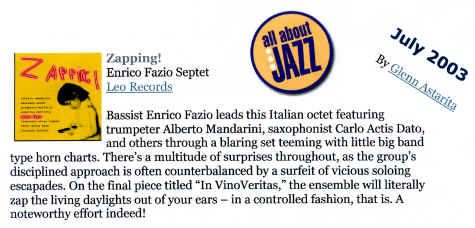The music of Enrico Fazio is an eclectic mix of such wilful diversity that in the hands of lesser musicians it could easily have turned out to be a stylistic mess. As it is the wayward complexity of his scores is so masterfully realised that the listener who can live with the twists and turns – what Fazio calls “harmonic and melodic side slipping” – will be rewarded with a recital that is bursting with incident that is as dramatic and exciting as it is humorous and thought provoking.
Shibui` is a Japanese word that denotes the blending of textures : sweet and sour, subtle simplicity with complexity etc , to create a new synthesis of taste or aesthetics and in Fazio’s music it finds expression in an amalgam of musical styles and sounds that despite their apparent incongruity merge almost seamlessly into a coherent whole.
His lively musical imagination combines advanced modern jazz with retro swing touches , gypsy jazz, European salon music, prog rock riffs , latin rhythms , New Orleans polyphony, cool jazz homophony as in the canonic title track, Balkan and Turkish Phrygian scales, serialism and a smattering of Mr Bojangles style hoofing in the final cut, “N.O.Tap”. Wow!
As well as this near bewildering variety of musical styles Fazio creates a delicious blending of instrumental sounds, pitting winds and brass against each other in what might appear potentially chaotic and un-harmonious combinations but actually produce a rich harmonic brew that is as satisfying to the ear as Turkish coffee is to the taste buds. Particularly potent in this context is the use of dark liquid sounds generated by the bass and contrabass clarinet and the thundering choruses delivered by Virone’s baritone sax. Exotic instruments such as the marimba like Balafon and the deeply resonant Turkish clarinet also enhance this effect
One might find, in Fazio’s musical concept, some parallels with the musical ideology of Peter Apfelbaum, whose New York Hierogylphics Orchestra pursues a similar post – modernist agenda of mopping up diverse musical influences, but whereas the American likes to incorporate country and western style elements there are no guitars in Fazio’s line-up and therefore few obvious funk & blues clichés. This is European art house music devoid of any deeply held
ethnic commitments but there is nothing prissy or superficial about Fazio’s approach which is both simulating and entertaining and will be a joy to everyone who possesses a lively ear. This one I will play again.
Reviewed by Euan Dixon
